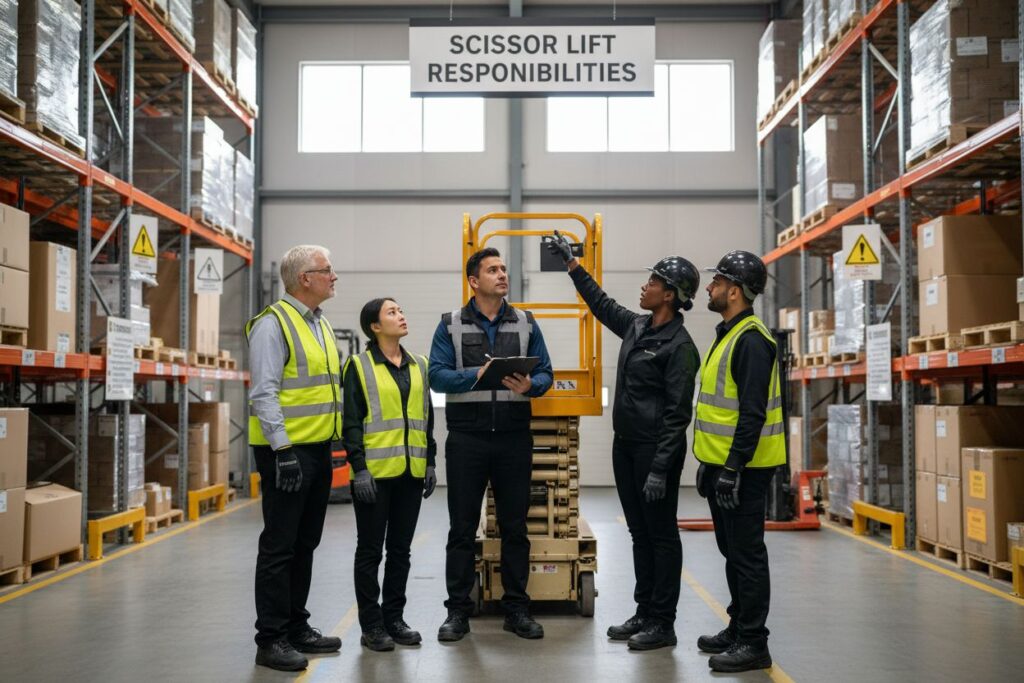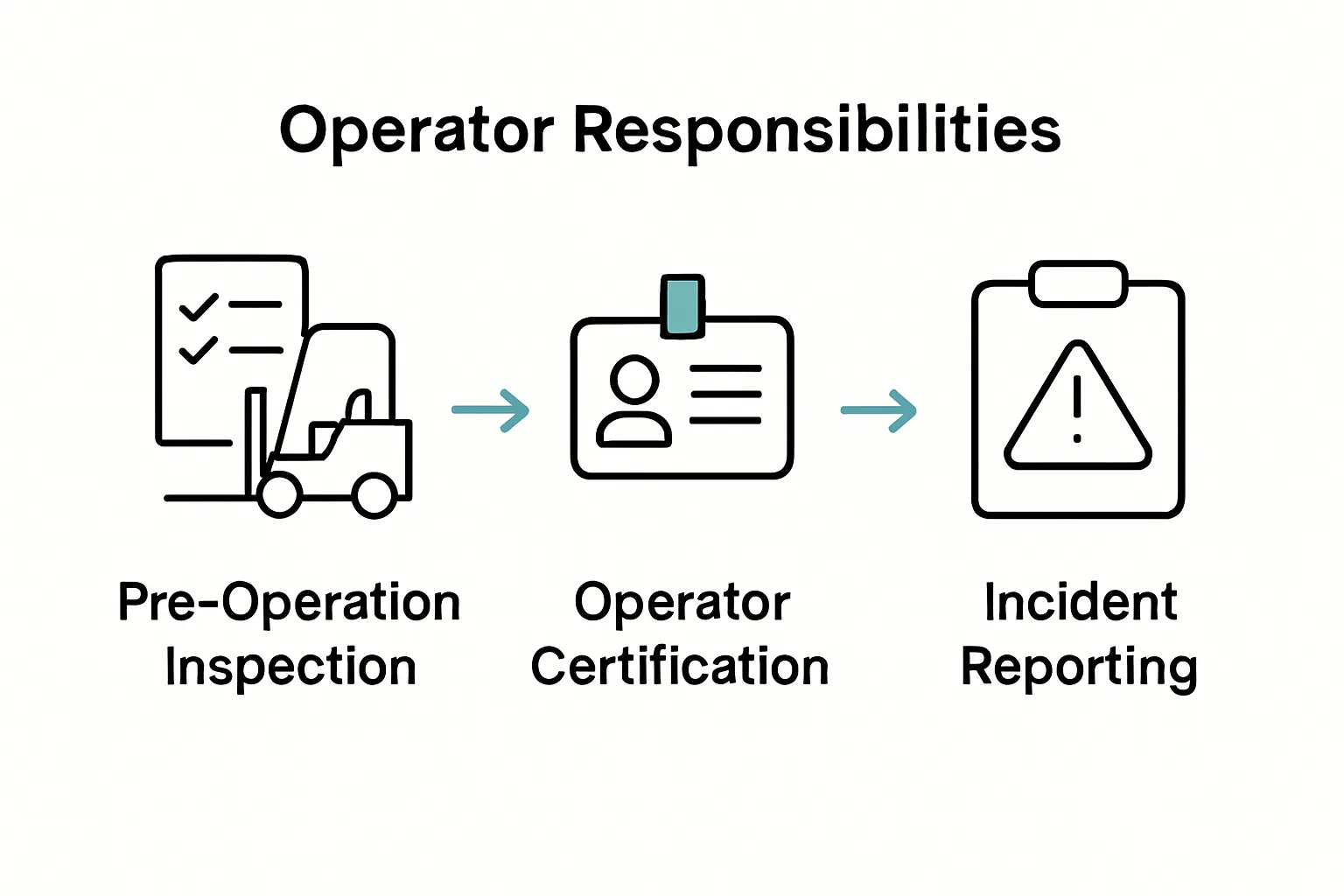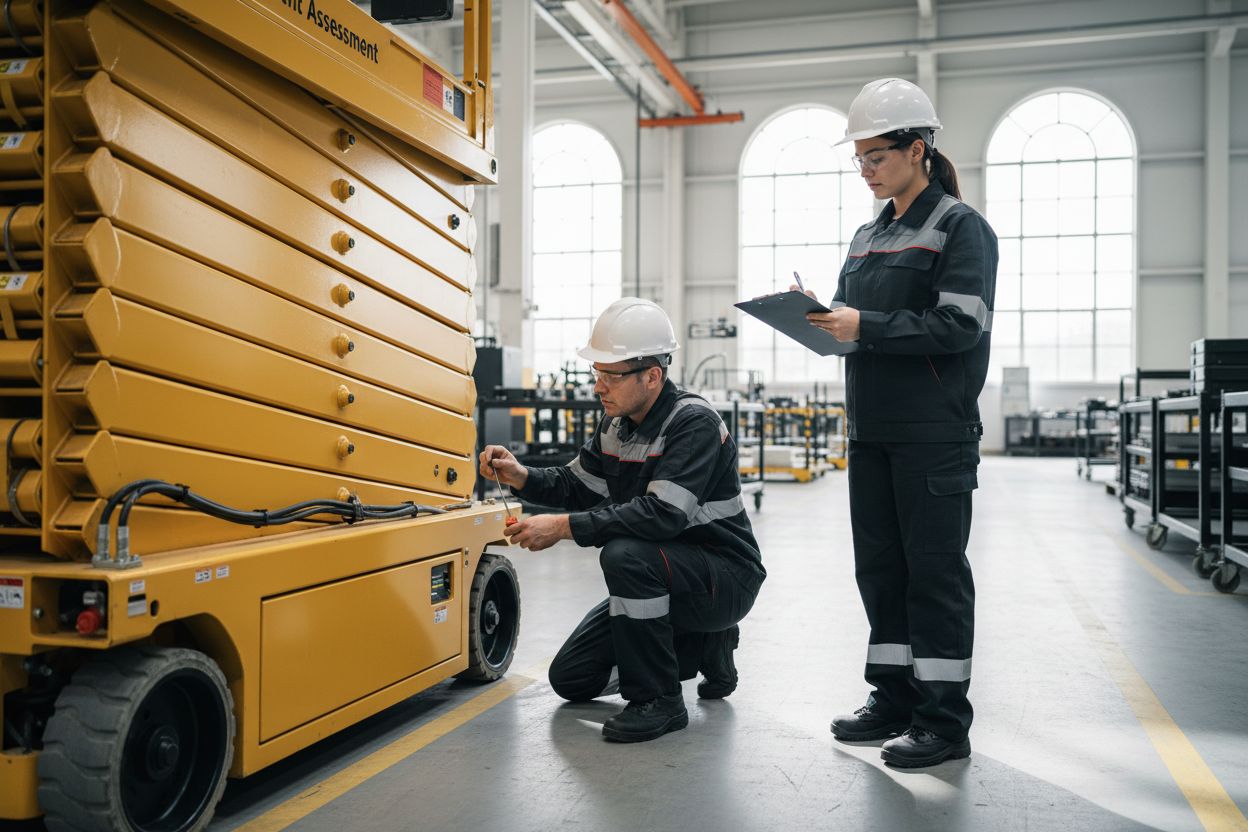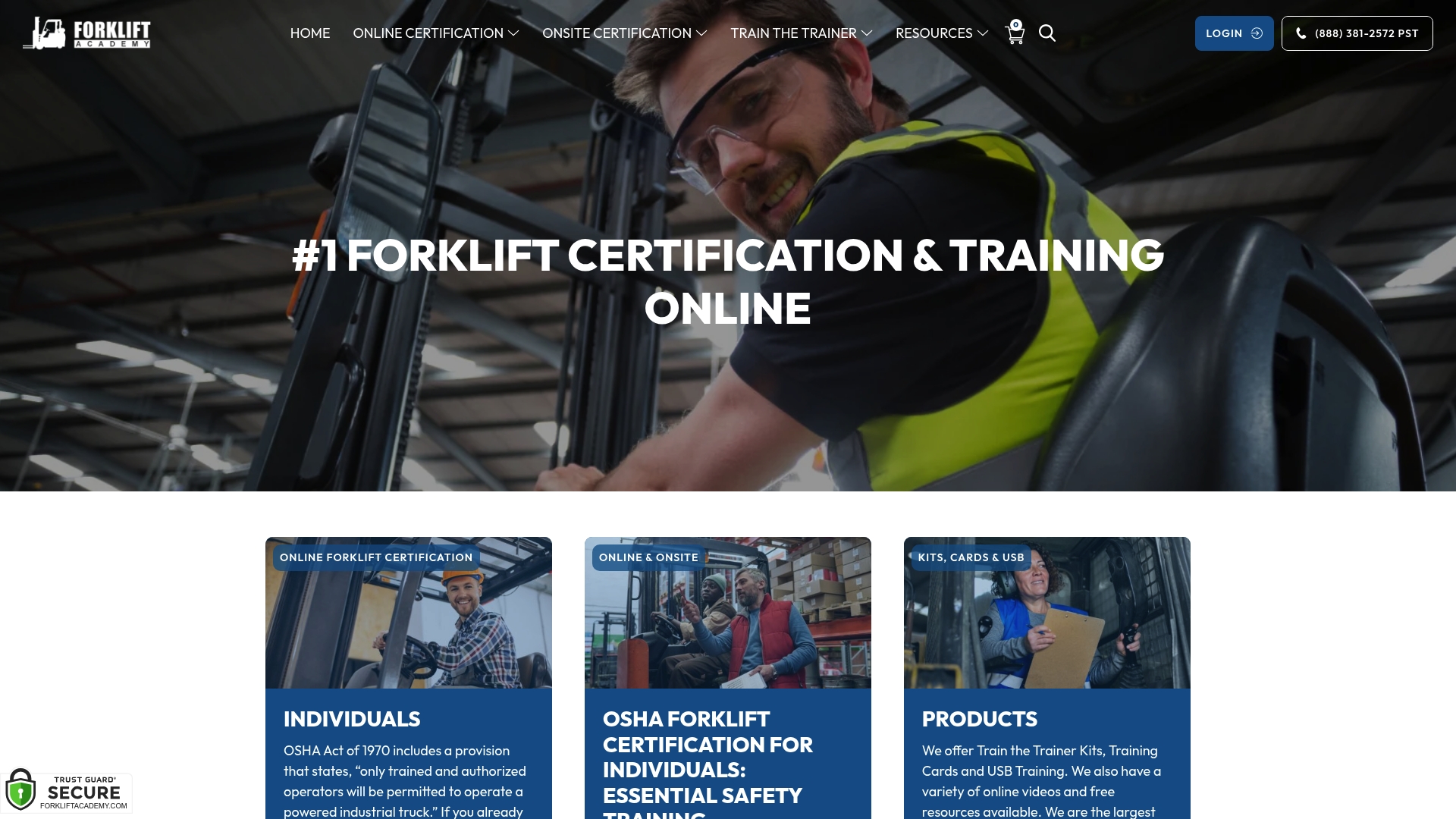
Scissor lifts are everywhere from busy construction sites to sprawling warehouses. These machines can lift workers as high as 40 feet into the air while supporting loads of up to 2,500 pounds. Most people focus on the power to rise and the convenience they offer. Yet the real story is how the operator’s actions shape safety for everyone around the lift. It is the human at the controls who turns a scissor lift from a helpful tool into either a lifeline or a liability.
| Takeaway | Explanation |
|---|---|
| Scissor lifts enhance vertical accessibility. | They enable workers to safely reach heights for tasks in various industries like construction and maintenance. |
| Operator training is crucial for safety. | Proper certification and adherence to safety protocols prevent accidents and ensure effective equipment use. |
| Pre-operation inspections are mandatory. | Operators must check equipment thoroughly to ensure mechanical integrity and safety before use. |
| Situational awareness is essential. | Operators should maintain vigilance regarding environmental hazards and potential risks during operation. |
| Compliance with OSHA regulations is vital. | Understanding and following legal safety standards reduces workplace incidents and promotes safe operations. |
Scissor lifts are versatile mechanical platforms designed to elevate workers safely to different heights in industrial, construction, and maintenance environments. These robust vertical mobility devices use linked, crossed metal supports that extend and contract in a scissoring motion, enabling precise vertical positioning.
The fundamental design of scissor lifts involves interlocking metal supports that move in a synchronized pattern. When hydraulic or electrical power is applied, these supports extend upward, creating a stable platform that can rise several meters from its base. The cross-hatch design provides remarkable stability, allowing workers to perform tasks at significant heights with minimal risk.
Key mechanical characteristics include:
Scissor lifts serve critical functions across multiple professional sectors. In construction, they enable workers to access hard-to-reach areas for electrical installations, painting, and structural maintenance. Warehouse operations utilize these machines for inventory management, high-shelf stocking, and equipment maintenance. Learn more about scissor lift applications in different workplace environments.
Manufacturing facilities rely on scissor lifts for equipment repair, assembly line modifications, and overhead maintenance tasks. Facilities management teams use them for ceiling repairs, lighting installations, and HVAC system work. The versatility of these machines makes them indispensable across numerous professional contexts.
According to OSHA guidelines, proper training and understanding of scissor lift operation are crucial for ensuring worker safety and preventing workplace accidents. Operators must comprehend not just the mechanical functions but also the critical safety protocols associated with these powerful lifting devices.
Scissor lift operator responsibilities extend far beyond simply moving a platform up and down. These professionals play a critical role in maintaining workplace safety, preventing accidents, and ensuring efficient operational performance. Understanding the depth of these responsibilities is fundamental to protecting workers and maintaining organizational productivity.
Operators bear significant legal and ethical obligations when managing scissor lifts. Understanding forklift operator responsibilities provides insight into the broader safety framework that governs equipment operation. OSHA mandates comprehensive training and strict adherence to safety protocols, recognizing that improper operation can lead to catastrophic workplace incidents.
Key compliance responsibilities include:
Professional scissor lift operators serve as frontline safety guardians. Their responsibilities involve continuous risk assessment, understanding equipment limitations, and implementing proactive safety strategies. According to workplace safety research, operators must consistently evaluate environmental conditions, recognize potential hazards, and make split-second decisions that prevent accidents.
Beyond technical skills, successful scissor lift operators must demonstrate exceptional situational awareness, communication abilities, and a commitment to maintaining a safe working environment. Their role transcends mechanical operation, positioning them as critical contributors to organizational safety culture.
Successful scissor lift operators are highly skilled professionals responsible for much more than simply raising and lowering platforms. Their role demands a comprehensive understanding of equipment mechanics, safety protocols, and workplace dynamics.

Before initiating any lift operation, operators must conduct thorough equipment evaluations. Learn what must be done daily before equipment use to understand comprehensive safety checks. This critical responsibility involves examining mechanical components, hydraulic systems, electrical connections, and structural integrity.
Essential pre-operation inspection criteria include:

Scissor lift operators serve as primary safety guardians, requiring constant vigilance and proactive risk management. They must continuously assess environmental conditions, potential obstacles, ground stability, and surrounding worker activities. According to occupational safety guidelines, operators are responsible for creating safe operational perimeters and communicating potential hazards to nearby personnel.
Beyond technical competence, successful scissor lift operators must demonstrate exceptional situational awareness, quick decision-making skills, and an unwavering commitment to workplace safety. Their responsibilities extend far beyond mechanical operation, positioning them as critical contributors to organizational safety culture and operational efficiency.
Below is a table summarizing the key responsibilities of a scissor lift operator, organized by task area and the focus of each responsibility for quick reference.
| Responsibility Area | Key Focus | Example Activity |
|---|---|---|
| Pre-Operation Inspection | Ensuring mechanical and safety integrity | Inspecting tires, hydraulic fluids, guardrails |
| Operational Safety | Maintaining situational awareness and communication | Creating safe perimeters, informing nearby personnel |
| Documentation & Compliance | Maintaining legal and procedural records | Filling operational logs, incident reporting |
| PPE and Physical Safety | Personal protection and risk minimization | Wearing appropriate equipment (PPE) |
| Equipment Operation | Following technical protocols and safety features | Testing emergency stop, confirming weight limits |
Scissor lift safety measures and regulations form a comprehensive framework designed to protect workers, prevent workplace accidents, and establish clear operational guidelines. These standards are not merely recommendations but critical legal requirements that organizations must implement to ensure worker protection and operational integrity.
Understanding OSHA compliance is fundamental for scissor lift operators and their employers. The Occupational Safety and Health Administration establishes stringent guidelines that cover every aspect of equipment operation, from training requirements to specific technical standards. These regulations mandate comprehensive safety protocols that address potential workplace hazards and minimize risk exposure.
Key regulatory requirements include:
Modern scissor lifts incorporate multiple integrated safety mechanisms designed to prevent accidents and protect operators. According to workplace safety research, these technical safeguards include emergency stop buttons, automatic leveling systems, overload sensors, and comprehensive monitoring electronics that continuously assess operational conditions.
Operators must understand not just the existence of these safety features but their precise function and activation procedures. This knowledge transforms technical specifications into practical safety strategies, enabling workers to respond effectively to potential equipment malfunctions or unexpected workplace challenges. The intersection of regulatory compliance, technical understanding, and practical skill defines true professional competence in scissor lift operation.
Scissor lift operators encounter diverse and complex scenarios across multiple industries, requiring adaptability, technical expertise, and a comprehensive understanding of both equipment capabilities and workplace dynamics. The practical implementation of scissor lift operations extends far beyond theoretical knowledge.
Learn how to avoid injuries while operating equipment provides insights into the nuanced challenges different sectors present. Construction environments demand precise positioning and stability, while warehouse operations require efficient vertical mobility. Manufacturing facilities necessitate intricate maneuverability around delicate machinery and complex production layouts.
Unique challenges for different industries include:
Successful scissor lift operators must develop sophisticated situational awareness and problem-solving skills. According to workplace safety research, adapting to dynamic environments requires continuous training, mental agility, and an understanding of potential risk factors.
Operators frequently encounter scenarios requiring split-second decision-making, such as adjusting to sudden wind changes, managing unexpected load distributions, or responding to emerging safety concerns. These challenges demand not just technical proficiency but also psychological resilience and a proactive approach to workplace safety.
The following table compares scissor lift operational challenges across common industries, providing a clear view of the unique demands faced in different environments.
| Industry | Unique Operational Challenge | Typical Workplace Demand |
|---|---|---|
| Construction | Uneven terrain and unpredictable environments | Stability and height precision |
| Warehouse | Narrow aisles and high-density storage | Efficient vertical access |
| Manufacturing | Restricted movement around sensitive equipment | Intricate maneuverability |
| Maintenance | Accessing complex structures | Adaptability to varied workspaces |
| Event Management | Temporary, changing workspaces | Fast, safe positioning |
Are you responsible for operating or supervising scissor lifts, but worried about meeting strict OSHA compliance standards? The article highlights how critical it is to understand pre-operation checks, risk assessment, and regulatory protocols. Lapses in these areas put workers and businesses at risk. Fortunately, you do not have to face these challenges alone—our specialized Forklift Safety resources can help you strengthen your safety culture and reduce accidents.

Make safety and certification a priority today. Discover our proven Forklift and Scissor Lift Certification solutions with flexible online and onsite options tailored for both individuals and businesses. Start your journey at Forkliftacademy.com for fast, OSHA-compliant training that turns responsibilities into real-world skills. Act now to protect your team and meet all regulatory requirements.
Scissor lift operators are responsible for ensuring safety during operations, performing pre-operation equipment inspections, maintaining operational logs, communicating hazards to personnel, and adhering to compliance regulations.
Operators must conduct thorough pre-operation checks, wear appropriate personal protective equipment, and continuously assess environmental conditions to ensure a safe working environment.
Operators should familiarize themselves with OSHA guidelines, participate in training programs, perform regular equipment inspections, and maintain clear documentation of operations and safety practices.
Common challenges include navigating uneven terrain in construction, managing narrow spaces in warehouses, and maneuvering around delicate machinery in manufacturing environments.